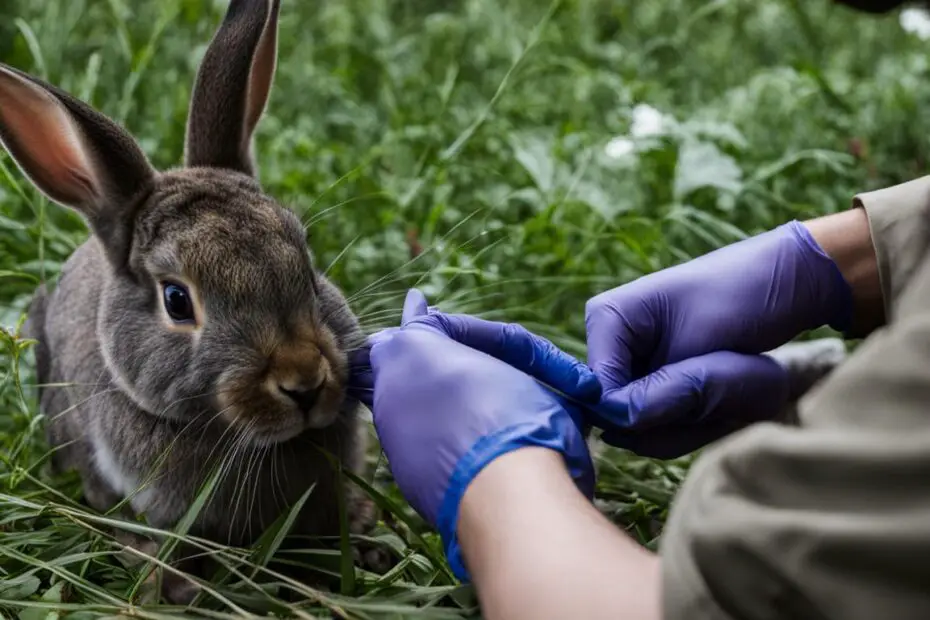When it comes to caring for a wild rabbit, it’s important to understand the different scenarios that might arise. If you come across a baby rabbit that is independent and uninjured, it is best to leave it be as mother rabbits only visit their young a few times a day. If the nest has been disturbed, covering it lightly and monitoring the mother’s return is recommended. However, if you come across an injured or orphaned rabbit, there are steps you can take to provide them with the care and support they need.
Wild rabbits require specialized care, especially when injured or orphaned. This article will guide you on how to properly care for a wild rabbit in need, ensuring their well-being and eventual return to their natural habitat.
Key Takeaways:
- Leave uninjured and independent baby rabbits alone, as their mothers provide care in short intervals.
- If the nest has been disturbed, lightly cover it and monitor the mother’s return.
- Take necessary precautions when handling injured or orphaned wild rabbits, such as wearing gloves.
- Prepare a suitable container for transportation, ensuring the rabbit’s safety and minimizing stress.
- Contact a licensed wildlife rehabilitator for professional assistance and guidance.
Protecting and caring for injured or orphaned wild rabbits requires knowledge and caution. In the next sections, we will explore how to prepare yourself, find professional assistance, and provide proper feeding for these delicate creatures. Let’s ensure the well-being of these furry friends!
Protecting Yourself and Preparing a Container for the Rabbit
When it comes to wild rabbit health care and raising baby wild rabbits, it’s important to take appropriate measures to protect yourself and provide a safe environment for the rabbit. Here are some essential steps you should follow:
- Wear gloves: Before handling an injured or orphaned wild rabbit, make sure to wear protective gloves to prevent any potential scratches or bites. This will help minimize the risk of contracting zoonotic diseases and ensure your safety.
- Prepare a sturdy container: Use a sturdy box or animal carrier to transport the rabbit. Make sure the container has proper ventilation and is secure enough to prevent the rabbit from escaping. Line the bottom of the container with a soft cloth or straw to provide a comfortable space for the rabbit.
- Consult a licensed wildlife rehabilitator: It’s crucial to avoid giving the rabbit any food or water until you have consulted with a licensed wildlife rehabilitator. They will provide guidance on the appropriate diet and care for the rabbit.
- Keep the rabbit in a warm, dark, and quiet place: During transport, it’s important to keep the rabbit in a calm and stress-free environment. Place the container in a warm and quiet area of your vehicle to minimize any additional discomfort for the rabbit.
By following these precautions, you can ensure the safety of both yourself and the wild rabbit you are caring for.
“Taking the necessary steps to protect yourself and preparing a suitable container is crucial for the well-being of the rabbit and your own safety.” – Dr. Sarah Thompson, Wildlife Rehabilitation Expert
Now that you’ve taken measures to protect yourself and prepare a container for the rabbit, you are ready to seek further assistance and provide proper care. In Section 3, we will discuss how to find professional help and ensure the rabbit’s nutritional needs are met.

Finding Assistance and Providing Proper Feeding
When caring for an injured or orphaned wild rabbit, it’s crucial to seek professional assistance if you are unable to transport the animal immediately. A licensed wildlife rehabilitator has the expertise and resources to provide the care and rehabilitation needed for the rabbit’s well-being.
Feeding the rabbit an incorrect diet can have serious consequences, potentially leading to injury or even death. It’s best to wait for guidance from a wildlife rehabilitator before attempting to feed the rabbit yourself.
However, if you find yourself in a situation where you need to feed an orphaned domestic rabbit, it’s important to follow proper feeding guidelines. Using a syringe or eyedropper, feed the rabbit while keeping it upright to prevent aspiration. Avoid overfeeding, as it can cause digestive issues.
Gradually introducing solid foods as the rabbit grows and develops is also an essential part of its care. Consult with a wildlife rehabilitator for specific guidance on the appropriate diet for the rabbit’s age and condition.
Proper Feeding Guidelines for Orphaned Domestic Rabbits:
- Prepare a formula suitable for rabbits, as recommended by a wildlife rehabilitator.
- Fill a syringe or eyedropper with the formula.
- Gently hold the rabbit and feed it while keeping it upright.
- Administer small amounts, allowing the rabbit to swallow before giving more.
- Monitor the rabbit’s weight and adjust the feeding amounts accordingly.
- As the rabbit grows, gradually introduce solid foods, such as hay and fresh vegetables, while continuing to provide the formula.
Examples of Wild Rabbit Diet
| Food | Quantity | Frequency |
|---|---|---|
| Leafy Greens (e.g., kale, spinach) | A handful | Once daily |
| Hay | Unlimited | Throughout the day |
| Timothy Pellets | 1/4 cup | Once daily |
| Fresh Vegetables (e.g., carrot, broccoli) | A few small pieces | A few times per week |
Remember, it’s crucial to consult with a licensed wildlife rehabilitator for accurate and up-to-date information regarding the appropriate diet and feeding guidelines for wild rabbits.

Quick Habits to Prevent Wildlife Accidents
When it comes to preserving the well-being of wild rabbits and avoiding wildlife accidents, adopting a few simple habits can make a significant difference. By being mindful of their nesting habits and understanding their natural habitats, we can create an environment that promotes their safety and survival.
Check Before You Mow
Before mowing your lawn or allowing your pets outside, take a moment to check for rabbit nests. These nests are often hidden in tall grass or under shrubs, making them vulnerable to accidental destruction. By scanning the area before you start any outdoor activities, you can avoid disturbing these fragile habitats and protect the wild rabbits that call them home.
Proper Disposal and Cleanup
In addition to checking for nests, it’s essential to dispose of food containers properly and clean up litter that could pose a hazard to wildlife, including wild rabbits. Discarded food containers can attract curious rabbits and lead them into dangerous situations. Removing litter from outdoor spaces ensures that wild rabbits and other animals are not exposed to harmful substances or obstacles that could harm them.
“By being mindful of their nesting habits and understanding their natural habitats, we can create an environment that promotes their safety and survival.”
Keep Cats Indoors
Cats are natural hunters, and their presence in the outdoors can pose a serious threat to wild rabbits and other wildlife. To protect both wildlife and cats, it’s recommended to keep them indoors, especially during dawn and dusk when rabbits are most active. This simple step can help reduce predation and ensure that the natural balance of the ecosystem is maintained.
By adopting these quick habits, we can contribute to the preservation of wild rabbits and their habitats. With a little mindfulness and consideration, we can coexist harmoniously with these fascinating creatures.

Debunking Myths About Baby Rabbits
When it comes to caring for baby rabbits, it’s important to separate fact from fiction. There are several common myths that can lead to misunderstandings about their care. Let’s debunk these myths and uncover the truth about raising baby rabbits.
Myth: Adult rabbits will reject babies that have been touched by humans
Contrary to popular belief, adult rabbits will not reject their babies simply because they have been touched by humans. It is a common misconception that the scent of humans will deter the mother from caring for her young. However, rabbits have a weak sense of smell and rely more on visual and auditory cues to recognize their offspring. So, if you come across baby rabbits and need to handle them for their safety, rest assured that the mother is unlikely to reject them based on human scent alone.
Myth: Baby rabbits should be cared for by humans if their mother is absent
While it may be tempting to intervene and care for baby rabbits if their mother is nowhere to be found, it’s generally best to leave them alone unless they are in immediate danger or their mother is confirmed to be deceased. Mother rabbits only visit their young a few times a day to avoid attracting predators, so it is common for the mother to be absent for long periods. If you come across baby rabbits that seem healthy and uninjured, it’s recommended to leave them in their nest or create a makeshift nest nearby to provide the best chance of survival.
Myth: Baby rabbits can be fed cow’s milk or other common household foods
Another prevailing myth is that baby rabbits can be fed cow’s milk or other common household foods. This is not only untrue but can also be harmful to their delicate digestive systems. Baby rabbits require a specific diet that mimics their mother’s milk, which is high in protein and low in carbohydrates. It’s crucial to consult a wildlife rehabilitator or a veterinarian experienced in rabbit care for guidance on proper feeding techniques and appropriate formula or milk replacement options.
Myth: Baby rabbits can be raised alone without any socialization
Contrary to popular belief, baby rabbits require socialization for their overall well-being. Rabbits are highly social animals and thrive when they have companionship and interaction with others of their kind. If you are caring for an orphaned baby rabbit, it’s crucial to provide opportunities for socialization by introducing them to other rabbits of similar age and size. This will help them develop important social skills and prevent loneliness or behavioral issues in the future.
| Myth | Fact |
|---|---|
| Adult rabbits will reject babies touched by humans | False – Adult rabbits rely more on visual and auditory cues to recognize their offspring. |
| Baby rabbits should be cared for by humans if their mother is absent | False – It is best to leave healthy baby rabbits alone unless they are in immediate danger or their mother is confirmed to be deceased. |
| Baby rabbits can be fed cow’s milk or other common household foods | False – Baby rabbits require a specific diet that mimics their mother’s milk, and it’s important to consult a wildlife rehabilitator or a veterinarian for proper feeding guidance. |
| Baby rabbits can be raised alone without any socialization | False – Baby rabbits need socialization for their overall well-being and should be introduced to other rabbits for companionship and interaction. |
It’s essential to debunk these myths and ensure that baby rabbits receive the proper care they need for their well-being and survival. If you have any concerns about an injured or orphaned baby rabbit, it’s always best to seek guidance from a wildlife rehabilitator or a knowledgeable veterinarian experienced in rabbit care.
Conclusion
Caring for a wild rabbit in need can be a challenging but rewarding experience. By following proper precautions, providing a suitable container for transport, seeking professional assistance when necessary, and understanding the unique needs of baby rabbits, you can make a positive impact on their well-being. Remember to always prioritize the safety and health of both the rabbit and yourself and to consult with experts when unsure. With proper care and attention, injured or orphaned wild rabbits can have a chance at recovery and eventual release back into their natural habitats.
Whether you stumble upon an injured rabbit or come across orphaned babies, knowing how to care for them is crucial. Remember to protect yourself and prepare a container for transportation, avoiding feeding the rabbit until you can consult with a licensed wildlife rehabilitator. Finding professional assistance and providing proper feeding are important steps in ensuring the best care for wild rabbits. Additionally, incorporating quick habits to prevent wildlife accidents can contribute to their well-being and survival.
Wild rabbit care requires patience, knowledge, and resources, but the satisfaction of helping these animals is immeasurable. By understanding their needs, debunking myths, and taking proactive steps to protect their habitats, you can be a responsible caretaker and play a vital role in wild rabbit rehabilitation. Together, let’s continue to preserve and safeguard these precious creatures, ensuring their place in the natural world for generations to come.
FAQ
What should I do if I find a baby rabbit that is independent and uninjured?
It is best to leave the baby rabbit alone as mother rabbits only visit their young a few times a day.
What should I do if I disturb a rabbit nest?
If the nest has been disturbed, covering it lightly and monitoring the mother’s return is recommended.
How can I care for an injured or orphaned rabbit?
When dealing with an injured or orphaned rabbit, protect yourself, prepare a suitable container for transportation, and consult with a licensed wildlife rehabilitator for advice.
What should I feed an orphaned domestic rabbit?
If you need to feed an orphaned domestic rabbit, follow proper feeding guidelines, gradually introduce solid foods, and seek guidance if unsure.
How can I prevent wildlife accidents involving rabbits?
Check for rabbit nests before mowing your lawn or letting your pets outside, properly dispose of food containers, clean up hazardous litter, and keep cats indoors.
Is it true that adult rabbits will reject babies touched by humans?
No, this is a myth. Leave baby rabbits alone unless they are in immediate danger or their mother is deceased. Contact a wildlife rehabilitator for concerns.
How can I make a positive impact on the well-being of injured or orphaned wild rabbits?
By following proper precautions, providing a suitable container for transport, seeking professional assistance, and understanding the unique needs of baby rabbits, you can help their recovery and eventual release back into their natural habitats.


